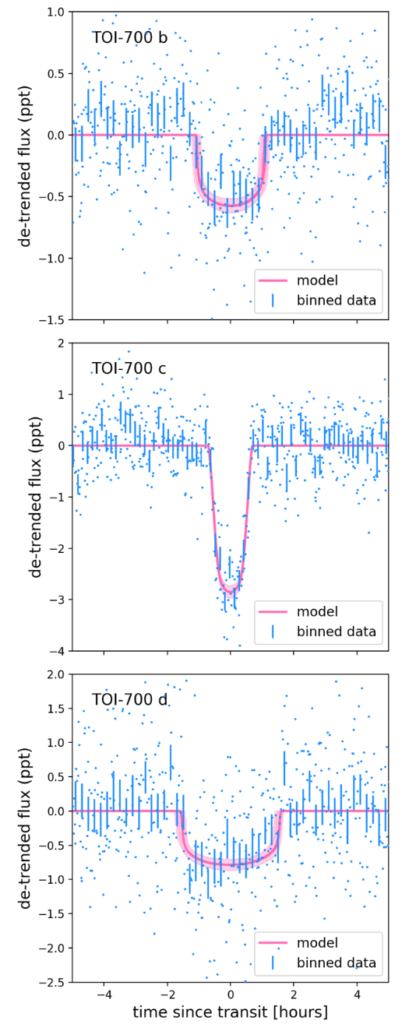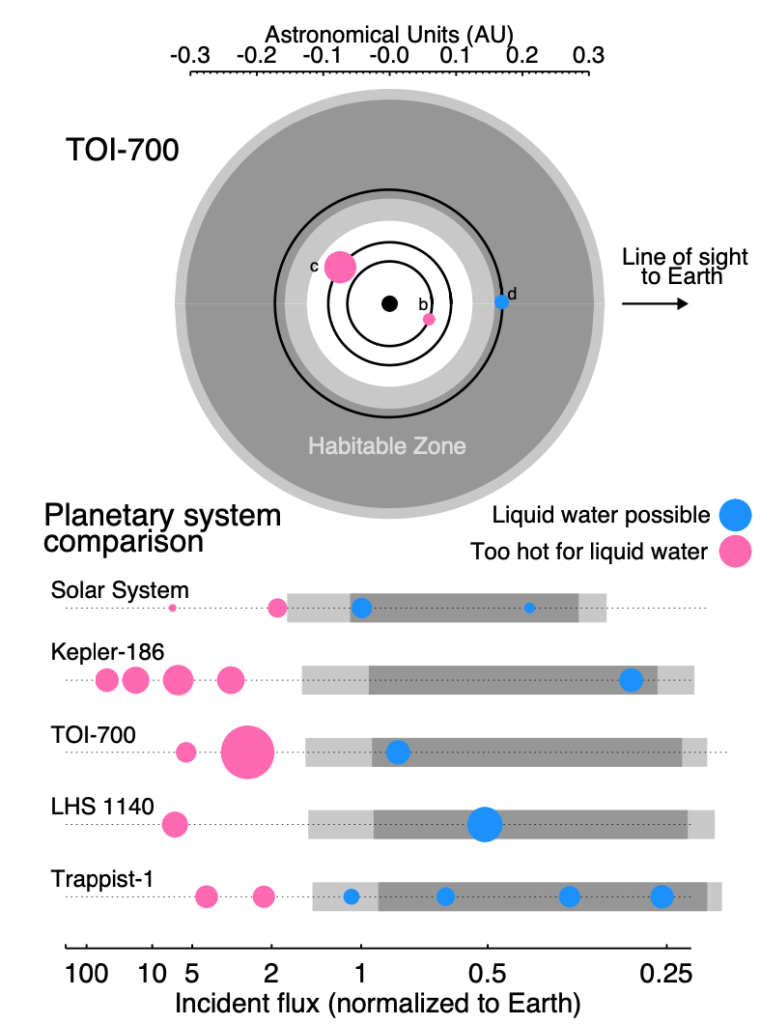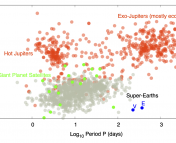Title: The First Habitable Zone Earth-sized Planet from TESS. I: Validation of the TOI-700 System
Authors: Emily A. Gilbert, Thomas Barclay, Joshua E. Schlieder, et al.
First Author’s Institution: Department of Astronomy and Astrophysics, University of Chicago, Chicago, Illinois, USA
Status: Submitted to AAS Journals, open access on arXiv
Since the discovery of the first planet outside of our solar system in 1992, the field of exoplanets has been booming with interesting finds. From the diamond planet orbiting a neutron star to the giant pink planet orbiting a star in the constellation of Virgo, telescopes all over the world have been racing to find the latest gem. Of particular interest are Earth-like planets. A team led by a graduate student at the University of Chicago report the first Earth-sized planet in the habitable zone found by the TESS mission, and its surroundings were quite a surprise to astronomers.
Searching for Planets in All the Right Places
Some of the biggest questions we humans like to ask are, “Is there life out there in the universe?” and “Are there other solar systems out there with planets just like ours?” To answer these questions, astronomers have built larger and more advanced telescopes to try to find planets outside of our own neighborhood, specifically those similar to our own world. The Kepler mission was launched in 2009 specifically to search for these kinds of planets: Earth-sized planets in Earth-like orbits around Sun-like stars in order to study how common they are in the universe. The mission has made many amazing discoveries, such as an exoplanet with the density of Earth, a planet in a binary star system, and the first Earth-sized planet in the habitable zone of its star that orbits around an M dwarf star that is about half the size of the Sun. Kepler’s extended mission, K2, focuses on low-mass stars which has led to the discovery of hundreds of small planets, some even in the habitable zone of their stars. Together, Kepler and the K2 mission have found over 3,000 new exoplanets.
Exoplanets are very small and very far away, so it is very difficult to find them. Astronomers use four methods: the transit method (which looks at how much a star dims as a planet goes in front of it, or eclipses it), the wobble method (which looks at how a planet and a star move around a common center of mass), direct imaging (which means taking a picture of the planet, straightforward but very difficult and limiting), and microlensing (which happens when light from a distant star bends around a star/planet system). TESS, or the Transiting Exoplanet Survey Satellite, was launched in 2018 and was designed to search for small planets around the Sun’s nearest neighbors using the transit method. In today’s paper, we discuss the first results of Earth-sized planets found in the habitable zone of an M dwarf star, planets contained in an odd planetary trio.
The Host Star
Understanding the properties of the host star is key in determining the habitability of the planets around it. M dwarf stars are smaller and dimmer than the Sun but are much more common in the Universe. The star that the team found the planets around is called TOI-700. To determine its fundamental properties such as mass and temperature, the team used three different methods in order to validate their results. After using known relations, checking their spectral energy distributions against known spectra, and using spectroscopy, they concluded that the star has an effective temperature of 3480 K (which is about ⅔ of the Sun’s temperature) and a mass and radius that is about half that of our Sun. They found no flares from the star in the observations over five years, which points to a low amount of magnetic activity, making the system more likely to be habitable.
Goldilocks (Zone) and the Three Planets
By analyzing how much the stars dimmed as the planets went around it, the team determined that there were three planets around it with radii of 1.01 ± 0.09, 2.63 ± 0.4, and 1.19 ± 0.11 Earth radii from inner to outer (respectively called TOI-700 b, TOI-700 c, and TOI-700 d). Figure 1 shows how much the planets dim the light of the star. TOI-700 b and d are likely Earth-sized while TOI-700 c is a sub-Neptunian-type planet. TOI-700 d receives about 90% of the energy that the Earth does from the Sun, which places it in the habitable zone of the star. After finding these planets, the team performed tests with many different software packages in order to verify their discoveries. Each of the three planets passed these tests with a false-alarm probability (the probability that the signal is due to something else like instrument noise) of less than 1%. The masses of the planets were determined to be ~1.07 Earth masses, ~7.48 Earth masses, and ~1.72 Earth masses for planets b, c, and d respectively.

So How Does One Make a Neptune Sandwich…?
The fact that the largest planet is in the middle of this system is a bit puzzling. Usually planets in a given system have similar sizes and in the case of our solar system, the inner planets are small and rocky while the outer planets are larger and gaseous. In this system, the low-density gas planet is sandwiched between the higher-density rocky planets with similar masses. Figure 2 shows the planet in comparison to other systems. The team postulates that this could have come from the two inner planets forming faster and accreting significant gaseous envelopes and the outer one forming more slowly and accreting less gas, then the innermost planet loses its envelope somehow. It is also possible that the middle planet formed outside the outermost planet but migrated inward somehow, but how this could happen eludes the authors. This strange system may be difficult to explain, but it provides a rich laboratory for exploring the formation mechanisms of complex multi-planet systems.

Thirty years ago, we did not even know planets could exist on other stars. Now, we know of thousands with some of those planets possibly being habitable. New exoplanet discoveries like this one are shaking up the field of planetary formation and causing us to rethink our ideas of what stars could host planets and how planets form. As time goes on, new telescopes like James Webb Space Telescope will come online and expand the number of exoplanets. Who knows what kind of weird extra-solar planets we will find next!




